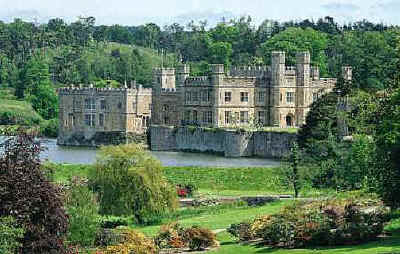Culpepper Connections
 During the reign of Edward II (14th century), Sir Thomas
Culpeper3 of Brenchley and Bayhall sided with the
Earl of Lancaster in a rebellion, and as a result, Sir Thomas was
hanged, drawn and quartered at Winchelsea. His son, Thomas4,
is believed to have been a porter or janitor of Leeds Castle.
During the reign of Edward II (14th century), Sir Thomas
Culpeper3 of Brenchley and Bayhall sided with the
Earl of Lancaster in a rebellion, and as a result, Sir Thomas was
hanged, drawn and quartered at Winchelsea. His son, Thomas4,
is believed to have been a porter or janitor of Leeds Castle.
Another son, Walter4, suffered for his refusal to
admit Queen Isabel to the Castle. Walter "sticked not to tell
him" (the Queen's marshal) "that neither the Queen nor
any other should be lodged there without the commandement of his
Lorde the owner." On the Queen coming to the gate in person
"the Captaine (Culpeper) most malapertly repulsed her,
insomuch that shee complained grievously to the King," who
besieged the place and eventually took it. "Then tooke he
Captaine Colepeper and hoong him up." (He didn't survive the
experience.)
In 1632 Leeds Castle was purchased, from Lady Elizabeth
Thornhill, by Sir
Thomas Culpeper12 (the elder) of Hollingbourne. Thomas was the
grandson of William Culpeper10, a direct
ancestor of the modern-day Culpeppers.
Thomas gave the Castle to his eldest son Sir Cheney Culpeper13
who remained in possession until his death in 1663, but the restoration
work that he undertook ruined him and he died deeply in debt.
His cousin, John, First Lord Culpeper13, had been a loyal servant of
Charles I, holding the offices of both the Chancellor of Exchequer and
Master of the Rolls and was also instrumental in conveying the Prince of
Wales (later Charles II ) into exile in France. In 1649 he was rewarded
for his loyalty by the gift of a large area of land in America comprising
all the land between the Potomac and the Rappahancock rivers, more than 5
million acres of Virginia. The rental payable to the Crown for this land
was £6-13s-4d per year.
Thomas, Second Lord Culpeper14 succeeded his father in the title and, using the
dowry of his wealthy wife Margaret, purchased Leeds Castle from the
creditors of Sir Cheney’s estate. During his ownership, but during his
absence, the castle was used as a prison for some 600 captured Dutch and
French sailors and extensively damaged.
In 1667 Lord Culpeper returned to Leeds but departed in 1680,
when he was Appointed Governor of Virginia. His daughter, the heiress Catherine15w,
married Thomas, Fifth Lord Fairfax in 1690 and eventually,
on the death of Lady Culpeper in 1710, Leeds Castle passed to the
Fairfax family which had held the Proprietary since 1690.
The American estate, however, was by no means secure, and over the next
50 years there was continual unrest as the settlers and the colonial
Government challenged the Fairfax ownership. The Sixth Lord
Fairfax finally achieved confirmation of the family’s sole rights in
1745, and then sailed for Virginia, the only Peer of the Realm ever to
emigrate to America. He gave Leeds Castle to his brother Robert
Fairfax.
Fairfax first settled at Belvoir on the banks of the Potomac, where he
became the friend and patron of the young George Washington and indeed
gave him his first job, to survey the new town of Alexandria. He later
moved nearer to the frontier in order to better supervise the development
of his estates and assigned to himself a property of 150,000 acres which
he called "The Manor of Leeds". When he died at the age of 89,
General Washington echoed the sentiments of the local population calling
him "the good old Lord."